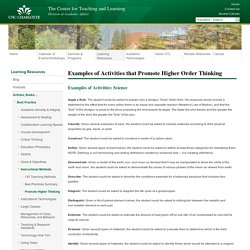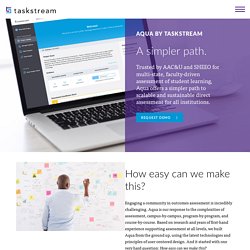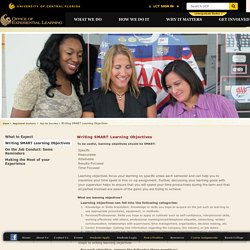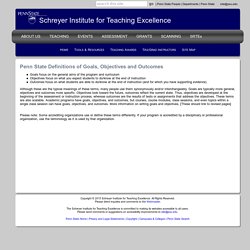

Skills for the 21st Century: teaching higher-order thinking. This article originally appeared in the April 2014 edition of ISQ Briefings, a publication of Independent Schools Queensland.

Republished with permission. It is hard to imagine a teacher or school leader who is not aware of the importance of teaching higher-order thinking skills to prepare young men and women to live in the 21st Century. However, the extent to which higher-order thinking skills are taught and assessed continues to be an area of debate, with many teachers and employers expressing concern that young people ‘cannot think’. What are we talking about when we talk about ‘higher-order thinking’? Brookhart (2010) identifies definitions of higher-order thinking as falling into three categories: (1) those that define higher-order thinking in terms of transfer, (2) those that define it in terms of critical thinking, and (3) those that define it in terms of problem solving.
While learning for recall requires thinking, the higher-order thinking is in ‘transfer’. 1. 2. 3. 4. 1. 2. 3. Examples of Activities that Promote Higher Order Thinking. Examples of Activities: Science Apply a Rule: The student could be asked to explain why a shotgun "kicks" when fired.

His response would include a statement to the effect that for every action there is an equal and opposite reaction (Newton's Law of Motion), and that the "kick" of the shotgun is equal to the force propelling the shot toward its target. Aqua - Taskstream. In 2014, the Association of American Colleges and Universities (AAC&U), the State Higher Education Executive Officers Association (SHEEO), and the Multi-State Collaborative (MSC) to Advance Learning Outcomes Assessment selected Taskstream as their technical partner for the MSC with funding from the Gates Foundation.

Aqua was the technology that helped the MSC to achieve its pilot vision. Our selection was both a great honor and a great undertaking: to engage nearly 200 assessment directors, data leads, and faculty scorers from 69 institutions in 9 states in a new system and get them up and running quickly with minimal support. So how easy did we make it? Examples of Activities that Promote Higher Order Thinking. Outcomes Assessment. Goals, Outcomes, and Objectives: What Are the Differences?

ABCD: The Four Parts of a Learning Objective. [This is the the fourth in a series of posts about learning objectives.

We’ve now compiled all the posts into a single downloadable guide to writing learning objectives if you want to check that out.] A simple way to make sure you’re building a useful learning objective is to use the ABCD method. Each letter in ABCD stands for a different part of your learning objective. These different parts answer four questions about your objective: who, what, how, and how well. The four parts of an ABCD learning objective are: A for ACTOR: Every learning objective should state something that the learner should do.
Note: In courses with multiple learning objectives, it’s fine to begin a list of objectives with something like “the learner must:” written only one time. B for BEHAVIOR: Every learning objective should state something that the learner must do—a behavior of some sort. Note: There may be times when a condition is not necessary, but always check to see if it’s appropriate to add one. Learning Outcomes. Most often we view results as the final outcome of an intervention that can easily be measured, such as reduced costs, customer satisfaction, improved quality, etc.

However, often the results are going to be internal to the targeted individuals. These are known as learning outcomes or personal results. Kraiger, et. el. (1993) proposed that learning during training may be classified into one of three types of outcomes: cognitive, skill-based, and affective. In addition, each type of outcome includes particular categories and foci of measurement (the focus is on two points): EffectiveUseofLearningObjectives. Office of Experiential Learning. Writing SMART Learning Objectives To be useful, learning objectives should be SMART: Specific Measurable Attainable Results-Focused Time-Focused Learning objectives focus your learning on specific areas each semester and can help you to maximize your time spent in this co-op assignment.

Further, discussing your learning goals with your supervisor helps to ensure that you will spend your time productively during the term and that all parties involved are aware of the gains you are trying to achieve. What are learning objectives? Learning objectives can fall into the following categories: Knowledge or Skills Acquisition: Knowledge or skills you hope to acquire on the job such as learning to use appropriate procedures, equipment, or methods. Writing SMART Goals. Goals, Objectives and Outcomes › Assessment Primer › Assessment › University of Connecticut. Outcomes Pyramid The assessment literature is full of terminology such as “mission”, “goals”, “objectives”, “outcomes”, etc. but lacking in a consensus on a precise meaning of each of these terms.

Part of the difficulty stems from changes in approaches to education – shifts from objective-based, to competency-based, to outcomes-based, etc. education have taken place over the years with various champions of each espousing the benefits of using a different point of view. The Outcomes Pyramid shown below presents a pictorial clarification of the hierarchical relationships among several different kinds of goals, objectives, and outcomes that appear in assessment literature.
The 'pyramid' image is chosen to convey the fact that increasing complexity and level of specificity are encountered as one moves downward. IACBE - Outcomes Assessment. Penn State Definitions of Goals, Objectives and Outcomes - Schreyer Institute for Teaching Excellence. Goals focus on the general aims of the program and curriculumObjectives focus on what you expect students to do/know at the end of instructionOutcomes focus on what students are able to do/know at the end of instruction (and for which you have supporting evidence) Although these are the typical meanings of these terms, many people use them synonymously and/or interchangeably.

Goals are typically more general, objectives and outcomes more specific. Objectives look toward the future, outcomes reflect the current state.